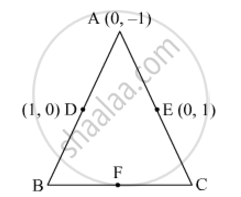Advertisements
Advertisements
प्रश्न
Find the area of a triangle whose sides are respectively 150 cm, 120 cm and 200 cm ?
उत्तर
The triangle whose sides are
a = 150 cm
b = 120 cm
c = 200 cm
The area of a triangle =`sqrt(s(s-a)(s-b)(s-c)`
Here 1s = semi perimeter of triangle
`2s=a=b=c`
`s=(a+b+c)/2= (150+200+120)/2 =235 cm`
area of triangle =`sqrt(s(s-a)(s-b)(s-c)`
`=sqrt(235(235-150)(235-200)(235-120))`
`=sqrt(235(85)(35)(115))cm^2`
`=8966.56cm^2`
APPEARS IN
संबंधित प्रश्न
In Fig. 6, ABC is a triangle coordinates of whose vertex A are (0, −1). D and E respectively are the mid-points of the sides AB and AC and their coordinates are (1, 0) and (0, 1) respectively. If F is the mid-point of BC, find the areas of ∆ABC and ∆DEF.

Find the area of the triangle PQR with Q(3,2) and the mid-points of the sides through Q being (2,−1) and (1,2).
Find a relation between x and y if the points (x, y), (1, 2) and (7, 0) are collinear.
The class X students of a secondary school in Krishinagar have been allotted a rectangular plot of land for their gardening activity. Saplings of Gulmohar are planted on the boundary at a distance of 1 m from each other. There is a triangular grassy lawn in the plot as shown in the following figure. The students are to sow seeds of flowering plants on the remaining area of the plot.

(i) Taking A as origin, find the coordinates of the vertices of the triangle.
(ii) What will be the coordinates of the vertices of Δ PQR if C is the origin?
Also calculate the areas of the triangles in these cases. What do you observe?
Find the value of k so that the area of the triangle with vertices A (k+1, 1), B(4, -3) and C(7, -k) is 6 square units
Show that ∆ ABC with vertices A (–2, 0), B (0, 2) and C (2, 0) is similar to ∆ DEF with vertices D (–4, 0), F (4, 0) and E (0, 4) ?
Find the value of x for which the points (x, −1), (2, 1) and (4, 5) are collinear ?
The table given below contains some measures of the right angled triangle. Find the unknown values.
| Base | Height | Area |
| 20 cm | 40 cm | ? |
If the points (a1, b1), (a2, b2) and(a1 + a2, b1 + b2) are collinear, then ____________.
The area of a triangle with vertices (a, b + c), (b, c + a) and (c, a + b) is ______.
